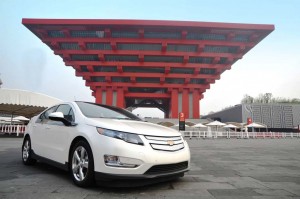When Toyota President Akio Toyoda outlined his company’s new “Global Vision,” which calls for sales to grow 20%, to 10 million annually, China was expected to play a key role, eventually accounting for 15% of the maker’s worldwide volume. (Click Here for more.)
And Toyota isn’t alone. Indeed, it’s hard to find a single manufacturer that isn’t betting on China, which is today the world’s largest new car market and which has posted growth, in recent years, that has at times approached triple digits.
But could the boom ready to go bust? With some analysts worrying about a bubble in the Chinese economy – and with some smog and traffic-snarled cities, notably including Beijing, taking steps to reduce vehicle sales – might car sales be peaking? The latest numbers certainly raise some flags.
True, Chinese car sales continued to grow in February, but at the slowest rate the Asian nation has seen in two years. Wholesale demand for passenger vehicles rose just 2.6% for the month. That’s the smallest increase since January 2009, when Chinese sales rose 7.8%.
There are plenty of markets where manufacturers would kill for those figures, but they’re almost dire when compared to the 32% increase in 2010. Of course, as industry officials also point out, the bigger the Chinese market grows, the harder it is to maintain such an intense pace.
Last year, the industry sold 18.06 million vehicles in China, marking the second year the country could lay claim to being the world’s largest market for motor vehicles. Notably, that’s well ahead of the previous U.S. all-time sales record. But many analysts have been forecasting that Chinese sales could hit 25 million in the next year or two and eventually surge to 40 million.
Such forecasts have led to massive investments in infrastructure. Already the country’s number one maker, General Motors recently launched a new brand, Baojun, to target first-time buyers in central China, where the benefits of the nation’s economic growth are just beginning to take hold. Even little Volvo, recently purchased by China’s Geely Holding Co., has announced plans to erect one, and probably two, Chinese assembly plants (For more on Volvo’s plans, Click Here.)
So, even a modest slowdown threatens to disrupt those industry plans. Players late to the game in China could wind up struggling to gain ground if February’s sales numbers aren’t just a temporary aberration.
The question is what’s behind the slowdown?
It certainly didn’t help when Beijing officials decided to cap sales to try to get a grip on the city’s ever-worsening traffic problems. Nor was it helpful when the Chinese government ended incentives for car buyers. That meant an extra 10% tax on small cars and the elimination of subsidies for trade-ins in rural parts of the country meant to get older, heavily polluting vehicles off the road.
Analysts suggest that the Chinese lunar calendar could also have played a role. Sales typically surge immediately before the new year holiday, but that occurred in January, this year, as opposed to February 2010.
But there are positive signs looking forward. China’s overall economy grew 10.3% in 2010, the fastest pace in three years, and if anything, both industry production and general retail sales continue to move at a torrid pace. The country’s automotive manufacturing trade association is forecasting that car sales will end 2011 with a 10 to 15% gain, which would move the market to somewhere around 20 million.


How do people making 10 cents an hour afford to buy a car?
First, that’s certainly not true of the folks at most of the transplants. One of the tricks to keep out the union has been to generally match what the UAW gets in its Big Three contracts — minus a bit, usually in terms of benefits. And with the two-tier agreements signed by the UAW and Detroit Three, I’m actually not sure that “domestic” workers won’t be earning slightly less, on average, in a few years.
(This is a very quick summary. We would need get into contract labor, etc., and that’s worth a treatise in itself, but the above is directionally accurate.)
What’s intriguing is that auto jobs have a tendency to drive up wages everywhere, with rare exception of countries where collusion with government leaders makes it impossible for workers to press demands for salary hikes. Consider Korea. By the time the economy overheated, a decade ago, workers at Hyundai were commanding total labor costs equivalent to autoworkers in Britain. The revaluation of the currency changed that, but don’t think that Koreans are working on the cheap anymore. That’s just incorrect.
Chinese labor rates vary hugely by maker and by region. Those in Shanghai have seen marked increases and are now in the $20,000/year range (Any readers want to weigh in with more complete data?) which, by Chinese standards makes them about as elite among the manual workforce as you can get. Now, go to the GM-SAIC-Wuling plant, in the south, and labor costs are significantly lower. But they’re also on the move up.
And you’ll likely see that happen over and over as makers add more factories moving westward towards the regions just feeling the Chinese economic “miracle.”
Where next? India, of course. Bangladesh? Maybe.
As Henry Ford realized, you NEED workers to get good wages to ultimately build a market for your cars. Right now, it can be argued that our industrial barons are shifting their focus abroad, with a heavy emphasis on emerging markets. But eventually, those nations’ standards rise and the labor advantages grow minimal, which is one of the reasons the Hyundais and Kias can justify building in the U.S.
Interestingly, UAW founder Walter Reuther once said that the only way to get to the point where capital stops playing worker against worker for lower costs is to bring up the standard of living everywhere.
Ironically, industry may be doing just that.
Paul A. Eisenstein
Publisher, TheDetroitBureau.com